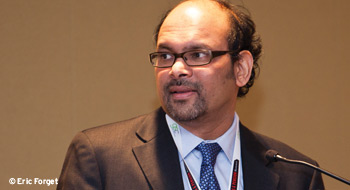

In a world where markets turn on a dime, the underlying economic fundamentals are often shoved to the side. “Diamonds are forever,” noted Avery Shenfeld, senior economist with CIBC World Markets, in an economist panel at the Benefits Canada Benefits & Pension Summit. “But when it comes to global economies, nothing else is really forever.”
Since the economic crisis, governments that ramped up speed in stimulating the economy are now pulling back “to seven lean years of activity,” he said, “as both governments and consumers de-leverage.” The global economy will return to a more normal state, he asserted, but “slow growth will be with us for a while.”
Emerging markets are the bright spot, noted Douglas Porter, deputy chief economist with BMO Capital Markets. While growth is flat or negative in developed markets, thanks to the emerging economies, global GDP growth is expected to hit 3% this year.
But “the European problem is a very long-term problem,” said Beata Caranci, deputy chief economist with TD Bank Financial Group, as more countries come up against Greek-style lending limits. In Canada, consumers worry that their debt could knock half a percentage point off GDP growth, she added.
Shenfeld thinks that while Chinese growth may slow, it has the capacity to spur growth, unlike European central banks. Added Porter, while “the Bank of Canada is warning of higher interest rates, pretty much the rest of the world is going in the opposite direction.”
More locally, the U.S. election cycle is creating a dilemma for the Bank of Canada, added Shenfeld. While it could be poised to raise interest rates as early as September, “the Bank of Canada will have to make a tough call.” The problem, as he noted, is that no one knows what U.S. politicians will do during the “lame-duck” period after November.
Risk management
In a “multi-speed, multi-differentiated world,” diversification is far from a panacea, said Rumi Masih, senior investment strategist with BNY Mellon Asset Management. Risk management should proceed instead from an analysis of how and why a portfolio is positioned.
Masih described five macroeconomic regimes that will affect portfolio assets differently: perfect, warming, cooling, too cold (deflation) or too hot (stagflation). Yet these investment regimes don’t succeed one another like the seasons of the year. Rather, knowledge of these regimes “should give an appropriate idea of the asset allocation from a risk management as well as a return standpoint,” Masih argued.
But is risk worth taking in the first place? A lot of actuaries once thought so, said Malcolm Hamilton, a principal with Mercer. All of the asset/liability modelling in the 1980s seemed to point in the direction of a 60/40 portfolio “for no apparent reason.” The modeling skipped two basic questions: Whose risk are you managing? and Why are they taking on risk?
Economists provided a partial solution: the lifecycle retirement savings model for individual retirement savings. In other words, assuming that people smooth their capacity to consume over their lifetime, saving when employed to draw down those savings in retirement. DB plans attempted to build on this—but, said Hamilton, “they got it wrong.” Plans assumed that the returns that investments earned were largely independent of interest rates and that pension funds could be treated like individuals with infinite investment horizons (i.e., they didn’t grow old and didn’t need to cut back their exposures to investment risk as they matured).
Unfortunately, at least in the private sector, they forgot about the shareholders. Economists had proven that the cost of a DB plan was essentially independent of the investment policy pursued by the pension fund. Guaranteed benefits should be priced using guaranteed interest rates, not the expected return on a pension fund heavily invested in risky assets. On the other hand, actuaries believed that taking on more risk would reduce funding costs and that short-term risk washed out in the long term. “Unfortunately, things didn’t work out,” Hamilton explained.
In the end, he argued, risk exists and must be shifted from the shareholders to the beneficiaries. “We’re in a very different state than what we thought we would be in, in the 1980s,” he noted. Clearly, risk-taking has a cost. It isn’t free.


